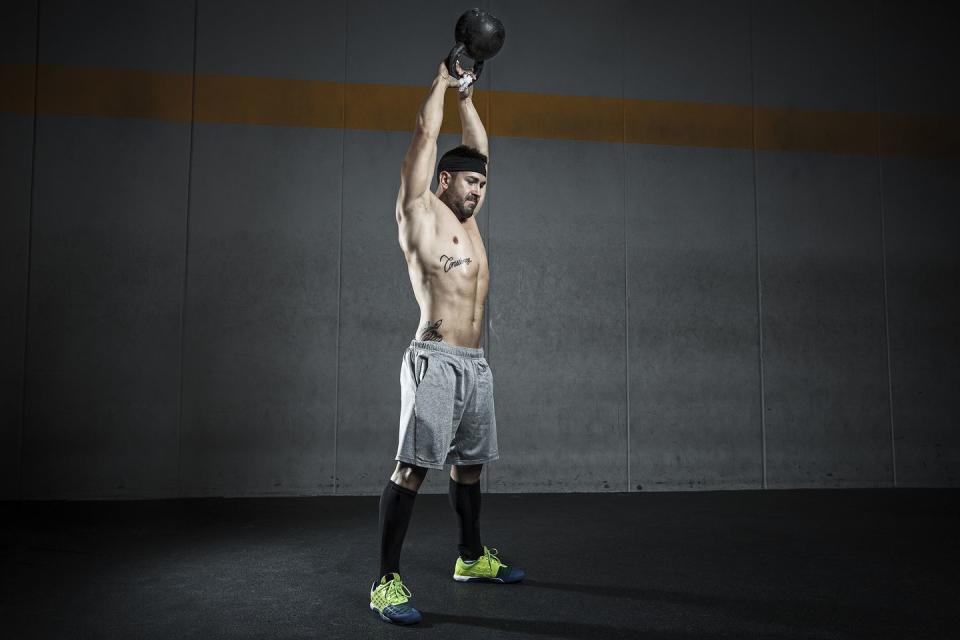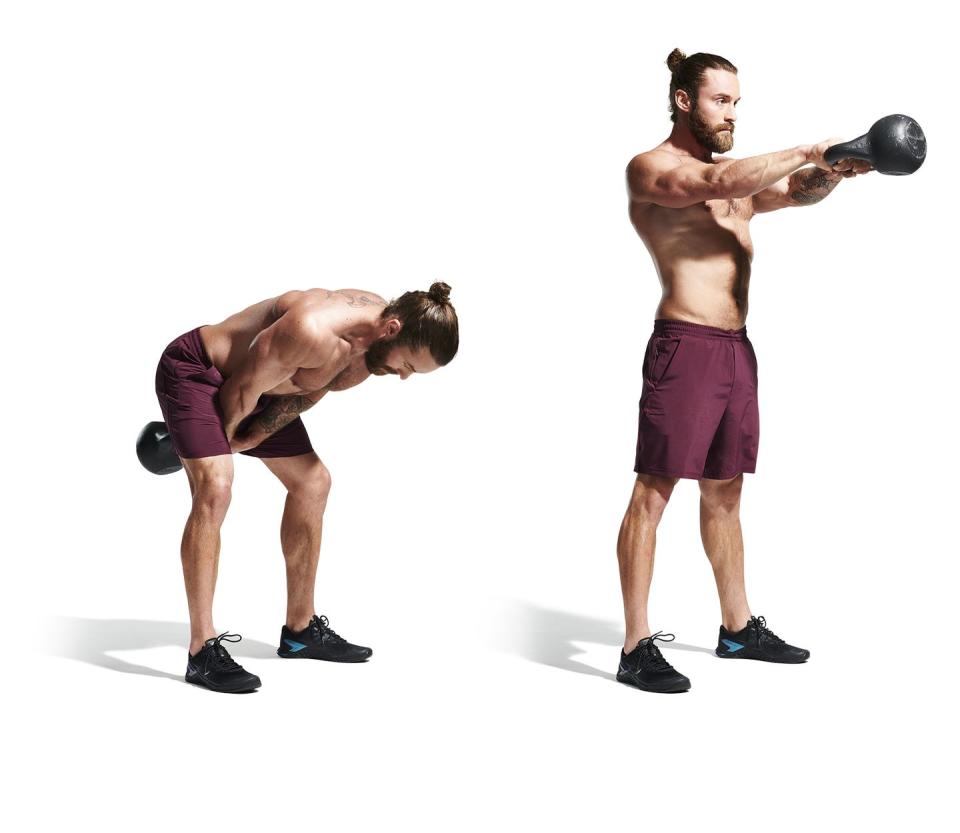Perfect Your Kettlebell Swing Technique to Build Explosive Power and Strength

A staple of many exercise classes, the kettlebell swing packs many benefits. Of course, there are the cardiovascular benefits, but a good swing will also result in muscular strength. They've even been shown to increase growth hormone and testosterone after training, meaning even more muscle gains.
But despite swings being frequently programmed, they're also frequently performed incorrectly. To do swings right, you need to nail the hip hinge, but this crucial element is often overlooked when learning how to do kettlebell swings.
Still, perform kettlebell swing correctly and you'll be well on your way to building explosive power and strength. Keep reading to find a step-by-step guide to the relatively advanced exercise, as well as info on the muscles it works and the variations that can take your swings to another level.

Why Do People Get Kettlebell Swings Wrong?
The most common variation is that the kettlebell swing can be performed in a hip dominant fashion and a knee dominant fashion. It's not that either of these are inherently wrong, but they do have different outcomes.
Strength coach and 5x world record powerlifter Jordan Syatt says, 'The kettlebell community, like all areas of fitness, is excruciatingly polarised. Depending on the certification and instructor, there are numerous techniques touted as the “right” way to kettlebell swing. While the various camps will argue day-in and day-out as to which swing is “best” the funny thing is they’re mostly similar hip-dominant variations with relatively insignificant differences. The preferred technique varies from person to person based on individual needs and goals.' So, it's important you always choose an exercise to suit your body and preferences.

Since the nature of the movement is a swing, it’s important to nail the technique to avoid injury. The beginning and end of the swing are crucial to get right. You should also avoid lifting the kettlebell with no momentum, which can result in participants completing a front raise to get the swing going.
According to MH US fitness director Ebenezer Samuel, 'Bodybuilders tend to do kettlebell swings like this because they’re breaking the motion back into two bodybuilding motions. This doesn’t just miss the point of a kettlebell swing (hip extension), but it’s dangerous for your shoulders too. You end up trying to finish the swing with your shoulders, placing your rotator cuff tendons in a compromised position.'
Let's have a closer look at the kettlebell swing so that you avoid the common pitfalls.
Which Muscles Do Kettlebell Swings Work?
The kettlebell swing mainly works the posterior chain muscles, so it works your:
Back: By keeping the shoulder blades retracted and down, you are working your back during the swing. You are also improving your back strength by keeping your torso rigid. Imagine keeping your shoulder blades in your back pocket so that your back stays strong throughout the movement.
Core: The dynamic nature of the swing means you must work your core and keep it tight in order to stay grounded throughout the exercise. Think about drawing your belly button to your spine during the movement to keep your core engaged.
Glutes: The hinge in the swing means that the glutes are working hard throughout the exercise. The squeeze at the top of the movement, extending the hips forward, enables your glutes to become more powerful and strong. Focus on an explosive snap of the hips to work your glutes harder.
Hamstrings: As you lean forward in the hinge, you also get a big stretch in the hamstrings before you snap the hips and they are contracted. The kettlebell swing is a fantastic move for hamstring mobility and power. Feel a big stretch in your hamstrings as your torso comes to parallel.
Quadriceps: While this muscle group isn't a part of the posterior chain muscles, it still has a big part to play in the swing, especially if a more knee-dominant variation is completed.
Calves: Due to the weight pulling you in alternate directions, the calves and ankles must work hard to keep us stable. Focus on the weight placement in the feet, try to keep the weight in the mid section of the foot throughout the movement so that you can keep balance.
How to do Kettlebell Swings
There are many variations of the kettlebell swing that we could teach you, but the most frequently used is the Russian swing. It’s recommended that you nail the kettlebell deadlift technique before trying it.

The Russian Swing
Start with the feet a little wider than the hips and with the kettlebell a foot distance in front of you.
Hinge the hips back behind your heels. Keep the head in line and reach forward to the kettlebell handle. Your torso should be slightly lifted above your hips.
Shrug the shoulders away from your ears to initiate the movement and pull the kettlebell powerfully between your legs, just above the knees
Snap the hips forward explosively to drive the kettlebell up to eye line.
Have a loose grip, let the momentum do the work.
Trace the arc shape in reverse, back between the legs.
Snap the hips and repeat until you finish the set. When you finish, reverse the kettlebell to the floor a foot in front of you.
Kettlebell Swing Variations and Alternatives
Dead Stop Swing
Why?
The perk with this variation is that you have already completed it at the beginning and end of the kettlebell swing. It could even be argued that the dead stop swing is a perfect precursor to learning how to do kettlebell swings. As a stand-alone exercise, the dead stop swing is perfect for increasing the kettlebell weight and therefore, your physical power.
How:
Start with your feet a little wider than your hips and the kettlebell a foot in front of you. Power the kettlebell between your legs and snap the hips forward to propel it to eye line. On the reverse journey, take the kettlebell back between the legs and then to the floor in the starting position. Reset and repeat.

Single-Arm Swing
Why?
The Single Arm Swing is a fantastic single limb (unilateral) exercise. Due to the nature of it being a single limb exercise, you are forced to ground yourself more, and therefore improve trunk stability. It's ideal for adding some more core focussed work to your training.
How:
Begin with the same set up as the dead stop swing and the kettlebell swing however this time reach forward with one hand. Swing the kettlebell in the same path as the previous variations and back to the ground. Focus on keeping your torso level and the weight in the mid section of your feet to keep balance.

American Swing
Why?
The American Swing includes the kettlebell travelling past eye line to the overhead position with a slight shrug at the top of the movement. The shrug at the top works your shoulders and traps so that you have an additional shoulder workout.
How:
Start with the normal dead stop swing and kettlebell swing set up. Complete the rep with a little more force and a little closer to the body so that the kettlebell can travel overhead. When it reaches the overhead position, don't let the weight travel behind you. Instead, shrug the shoulders slightly upwards and reverse the movement.
Kettlebell Swing Workout
Time to put all you've learned into to practice with this full-body kettlebell swing workout, programmed and demonstrated by fitness polymath, Joe Wicks.
You Might Also Like


